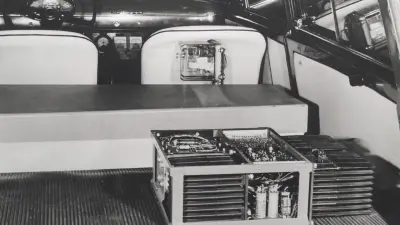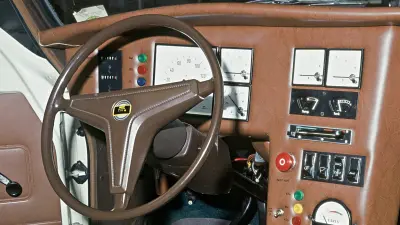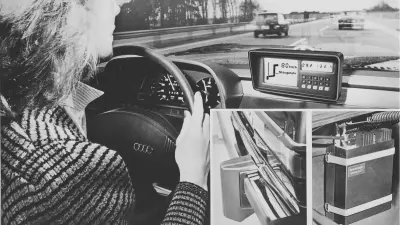Automated, electrified, connected: Looking back to the beginnings of Bosch’s three future mobility topics

Some innovations are ahead of their time, still in their infancy in terms of technology, or not yet ready to be made available to customers. However, taking a more long-term view, it often proves worthwhile sticking with these ideas and investing a lot of time and resources in them.
The future of the Mobility business sector at Bosch rests firmly on three development goals — “Automated”, “Electrified”, and “Connected”. However, the roots of Bosch expertise in these fields of activity lie far back in the past. They are shaped by milestones that were often too advanced for the times and are only now being manufactured in series production — automated, electrified, and connected.
Electrical experiments

Looking back, electrification is the first of the three development goals that Bosch set its sights on. Bosch began researching electric drive options for cars in spring 1967. At that time, electromobility was rare due to the gasoline engine having outpaced the electric motor around 1900 due to the greater range and energy density of its affordable fuel. During its work on this pioneering technology, Bosch reexamined the fundamental question of whether this noiseless drive technology — that uses electricity as a cost-effective energy source and doesn’t require expensive components such as the transmission — could be developed to the series production stage. Bosch was able to draw on its expertise in electric motors and battery development, and on newly-won knowledge from its ventures into the field of microelectronics. Bosch was also carrying out separate research into electrified car drives with braking energy recovery, batteries with greater energy density, and power electronics for controlling electric drives.
Instead of combustion
What’s more, Bosch was also opening up technological prospects against the backdrop of the first emission regulations, such as the clean air act announced by the U.S. Government in the mid-1960s. The shadow cast by this legislation also reached the core Bosch market in Europe, demanding research into alternatives to the internal-combustion engine.
Practical examples – electrified and hybrid
One important milestone came in 1971 with an Opel GT sports coupé fitted with electric motors and power electronics from Bosch. The test vehicle provided impressive evidence of the potential of electromobility, with driver Georg von Opel claiming several car-based world records. In 1972, Bosch undertook a pilot project for the Olympic Games in Munich, converting several BMW cars to electric drives to act as “zero emission” support vehicles for long-distance running races.
In that same year, tests began on electrically powered buses. The first daily public service began in Mönchengladbach in 1974, and as a diesel/electric hybrid in Stuttgart.
Parallel to this, in 1973, Bosch presented a hybrid car based on a Ford Escort with gasoline engine and electric motor.

Not enough range
However, even though the first oil crisis in 1973 opened the world’s eyes to the finite nature of fossil fuels for internal-combustion engines, this technology was ahead of its time. Bosch also carried out a research and development project on electric drives between 1977 and 1982 without gaining any subsequent contracts.
The range of 50 to 100 kilometers just wasn’t enough for customers and the battery technology available at the time simply wasn’t capable of more. Electromobility remained in the shadows, a niche technology initially limited to electric vehicles and forklifts on company premises.
Communication – the first step toward networking
In addition to potential in the field of electrified drive systems, Bosch also focused on communications technology for cars. The first car phone made by Bosch went into series production in 1985. In this respect, Bosch benefited from its experience in mobile communications; it had been active in this field since 1954, supplying police, fire departments, and other rescue services with radio equipment. The first car telephone, however, was still far from being ready for large-scale series production. The device cost over 6,000 German marks, more than half the price of a small car. In addition, the radio network for mobile telephony at the time was not sufficiently powerful for blanket coverage.
Nonetheless, it represented pioneering work, as did the development of navigation technology at Bosch. It all began with the development project for the driver guidance system ALI. Developed since the start of the 1970s in conjunction with universities and government institutions, it was tested on highways from 1978 in collaboration with Volkswagen AG. Induction loops in the road meant the traffic density could be calculated by a central mainframe computer. Based on this, recommendations for alternative routes were passed to the ALI receivers. Even before this, the Bosch subsidiary Blaupunkt had developed a traffic news decoder that enabled targeted monitoring of traffic reports and gave drivers the opportunity to avoid routes where traffic jams were likely.

Independent navigation in series

The crucial weakness in the existing technology pushed forward development work on independent navigation at Bosch. This represented a key step toward the networking of individual mobility today — after leaving the highway, drivers would be guided to their destination by a navigation system. Introduced in 1983, the Bosch prototype “EVA” electronic pilot for drivers anticipated features of today’s navigation systems. Based on a suitcase-sized on-board computer, a digital map, and wheel sensors, the system used a spoken voice to recommend routes. By 1989, this prototype had developed into the TravelPilot; from 1995, the second generation of this navigation system was also able to use the GPS global positioning system to determine precise positions. These marked the first steps in using interactions with other technologies to pave the way toward connected vehicles.
Automated driving put to the test
In addition to using these systems to help drivers negotiate day-to-day urban and highway traffic safely, researchers at Bosch were also focusing intensively on autonomous driving. Bosch had experimented with driverless buses on test tracks as early as the 1970s. However, with conductors set into the track surface and sensors fitted under the vehicle to control it, this method simply wasn’t suitable for conventional roads. By the start of the 1990s, the technology was in place to enable automated driving without the need for conductors in the road surface. Bosch carried out its first road tests in 1993.
These were not the result of one single project, but part of the European research project Prometheus, which sought to explore the technological potential of future individual mobility. Drawing on camera technology and evaluation electronics for road markings, traffic signs, and all other relevant parameters, the van converted by Bosch was able to travel many kilometers on the highway, over roundabouts, and through towns without any problems at all. There was a driver behind the wheel just in case intervention was required in the event of a malfunction. This demonstrated what was possible – but only as a research project. There were no plans for development to the series production stage.
The building blocks of progress
Bosch introduced the Adaptive Cruise Control (ACC) distance radar in 2000, marking a new approach to autonomous driving. Initially just an assistance system for more comfort and safety in luxury cars, ACC was based on cruise control and fitted with a radar sensor and electronic control. Depending on the traffic, this system can work independently to brake the vehicle or accelerate to a predefined speed.
The second generation can even come to a complete stop in traffic jams before starting off again. This meant that an independent speed adjustment system without driver intervention was now in series production. In 2008, the company expanded its product portfolio further still with a semi-automatic parking assistant that executes all steering movements automatically, marking a further step on the road to autonomous driving.

Connected and automated driving in combination
Like networking, automated driving is an evolutionary process whose origins are shaped by the merging and combination of individual functions. These can also include functions from completely different areas. Braking control systems such as ABS, ESP and the emergency braking assistant are designed as stand-alone functions. However, they can also be seen as subfunctions of automated driving; in the long term, these include automated avoidance and braking.
The same applies to the concept of networking – it covers not just networking vehicles with the Internet and other vehicles, but also networking functions. By linking technology, a warning issued by the navigation system about an upcoming traffic jam can also initiate deceleration and even emergency braking.
Learning from electromobility
Following numerous development projects in the automotive industry, public interest in all-electrical and hybrid solutions intensified around 2000 – and, this time, it was primarily ecological concerns that were generating support for the electric drive. Thanks to research into electromobility and automotive technology as a whole, the company had built up comprehensive expertise over several decades.
Digital electronics, micromechanical sensors, lithium-ion batteries, electric motors, and software know-how were the key technologies for work on future electric drives. A series-produced hybrid system for passenger cars was introduced in 2010, followed by a complete electric drive for a series vehicle in 2013.
“Automated”, “Electrified”, “Connected” combined
Automation, electrification, and connectivity are not three separate development goals. As subfunctions, they interact with each other to deliver safe, low-emission, economical driving. Networking via sensor- and Internet-based driver information influences automated driving if an accident occurs nearby and activates braking.
Electric driving also influences navigation if, for example, a low battery charge requires a diversion to the nearest charging station. Ultimately, it brings together many individual functions, using sophisticated software to create a network.
Author: Dietrich Kuhlgatz
